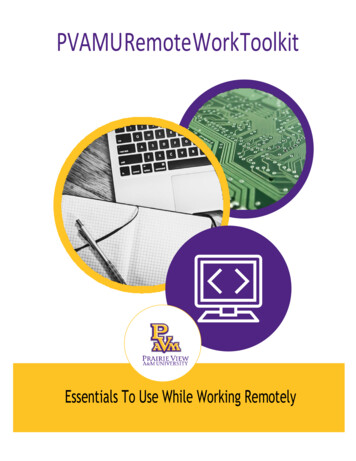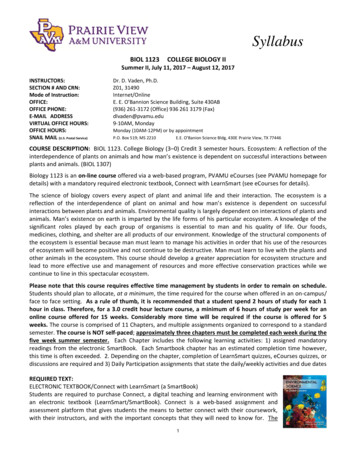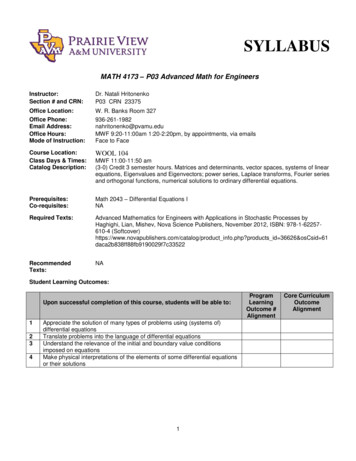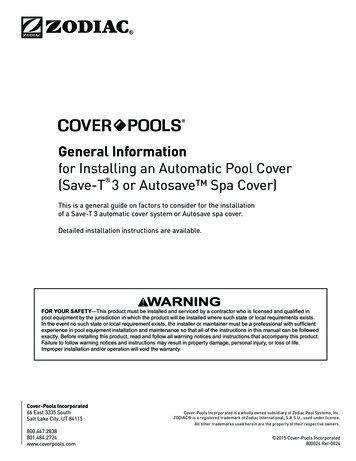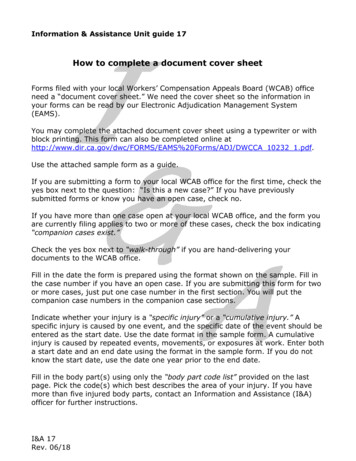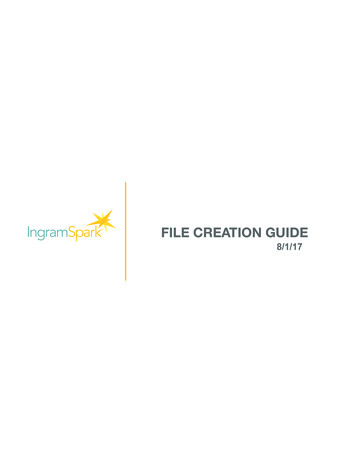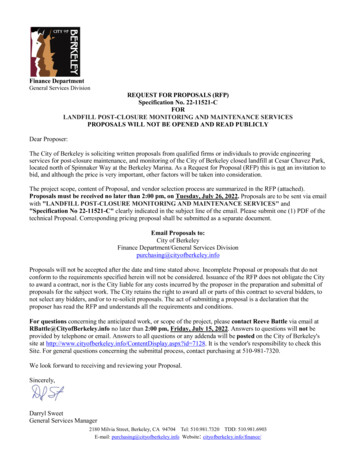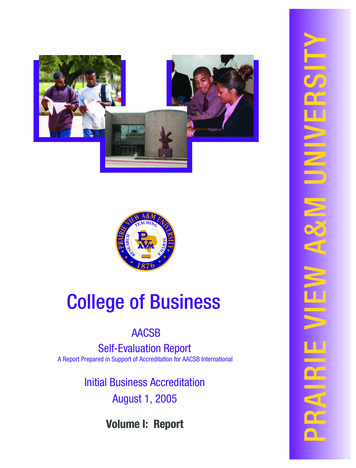
Transcription
!!#3"3ELF %VALUATION 2EPORT! 2EPORT 0REPARED IN 3UPPORT OF !CCREDITATION FOR !!#3" )NTERNATIONAL)NITIAL "USINESS !CCREDITATION!UGUST 6OLUME ) 2EPORT02!)2)% 6)%7 ! - 5.)6%23)49#OLLEGE OF "USINESS
Prairie View A&M UniversityCollege of BusinessAACSB InternationalSelf-Evaluation ReportInitial Business AccreditationAugust 1, 2005Volume I: Report
THE COLLEGE OF BUSINESSPRAIRIE VIEW A&M UNIVERSITYSELF EVALUATION REPORTTABLE OF CONTENTSList of Tables and Exhibits . iAcknowledgements. viPreamble. . ixPRECONDITIONSP.1 Eligibility. .1P.2 Programs within the Scope of Review for AACSB Accreditation. .4P.3 Readiness for Accreditation Review.6P.4 Accounting Accreditation.7MISSION AND OBJECTIVESM.1 Mission .10M.2 Mission Appropriateness.12M.3 Educational Objectives.16M.4 Relative Emphasis on Teaching, Intellectual Contributions, & Service .20M.5 Consistency of Activities with Mission.20FACULTY COMPOSITION AND DEVELOPMENTFD.1. Faculty Planning .27FD.2. Faculty Recruitment, Selection and Orientation.30FD.3. Faculty Development, Promotion, Retention, and Renewal.35FD.4. Faculty Size, Composition and Development.43FD.5. Faculty Qualifications.52-i-
CURRICULUM CONTENT AND EVALUATIONC.1 Curriculum Content.57C.2 Curriculum Planning and Evaluation .71INSTRUCTIONAL RESOURCES AND RESPONSIBILITIESIN.1 Instructional Resources.79IN.2 Collective Faculty Instructional Responsibilities .86IN.3 Individual Faculty Instructional Responsibilities .90STUDENTSS.1. Students .97S.2. Career Planning and Placement .113INTELLECTUAL CONTRIBUTIONSIC. 1 Intellectual Contributions.128TRANSITION PLAN .149- ii -
List of Tables and ExhibitsTable P.1.c-1Table P.1.c-2Table P.2.a-1Table P.3.a-1Exhibit P.1c-1Exhibit P.1c-2Exhibit M.1 -1Table M.2-1Table M.2-2Table M.5-1Table FD.1-1Table FD.1-2Exhibit FD.2.a-1Table FD.2.b-1Table FD.2.c-1Table FD.2.c-2Table FD 3.b-1Table FD 3.b-2Exhibit FD.3.b-1Table FD.3.c-1Table FD.3.c-2Table FD.4.a-1Table FD.4.b-1Table FD.4. b-2Table FD.4.b-3Table FD.4.b-4Table FD.4.b-5Table FD.4.b-6Table FD.4.b-7Table FD.4.b-8Full-time Faculty Profile by Discipline (Spring 2005) .2Relative Instructional Budget Analysis (2000-2004).2COB Enrollments by Majors and Programs (FallSemesters, 2000-2005).5COB Degrees Conferred (2000-2004) .6Prairie View A&M University Organizational Chart .8College of Business Organizational Chart.9Mission Statement Review Process .12University, COB Mission and Activities (2002-2005) .13Dean’s Advisory Board (Spring 2005) .15Standing Committees and Assignments (2004-2005).22COB Full-time Faculty Members – Spring 2005.28Policies and Processes on Faculty Development .30Hiring Procedures for Tenure-Track Faculty.31Faculty Orientation Survey Results (2004-2005) .33COB Full-Time Faculty Demographics (Spring 2005).34University Full-Time Faculty Demographics (Spring 2005).35Full-Time Faculty by Rank (Spring 2005).38Full-Time Faculty by Tenure (Spring 2005).38Tenure and Promotion Evaluation Procedures .39Faculty Professional Development Support.41COB Intellectual Contributions Seminars (2004-2005).42COB Faculty Qualifications and FT/PT Status (Spring 2005) .44Accounting Faculty Qualifications Rank, Degree,Qualifications, Teaching Status, and MFTE (Spring 2005).47Finance Faculty Qualifications Rank, Degree,Qualifications, Teaching Status, and MFTE (Spring 2005).47MIS Faculty Qualifications Rank, Degree,Qualifications, Teaching Status, and MFTE (Spring 2005).48Management Faculty Qualifications Rank, Degree,Qualifications, Teaching Status, and MFTE (Spring 2005).49Marketing Faculty Qualifications Rank, Degree,Qualifications, Teaching Status, and MFTE (Spring 2005).49Economics Faculty Qualifications Rank, Degree,Qualifications, Teaching Status, and MFTE (Spring 2005).50Faculty Computations by Discipline (2003–2005) .51Percentages of SCH Taught by Full-time Faculty byDegree Programs (Spring 2003–2005) .52- iii -
List of Tables and Exhibits (cont’d)Table FD.5-1Table C.1.1-1Table C.1.1-2Table C.1.2.a-1Table C.1.2.b-1Table C.1.2.c-1Table C.1.3.a-1Table C.1.3.b-1Table C.1.3.c-1Table C.1.4.b-1Exhibit C.2.1.1Table C.2.2-1Table C.2.2-2Table IN.1-1Table IN.1-2Table IN.2-1Table IN.3-1Table S.1.a-1Table S.1.b-1Table S.1.b-2Table S.1.b-3Table S.1.c-1Table S.1.c-2Table S.1.c-3Table S.2.a-1Table S.2.a-2Exhibit S.2.a-2Table S.2.a-3Table S.2.a-4Table S.2.a-5Table IC-1Exhibit IC-1Aggregate Faculty Computations, 2002-2005 .53Coverage of Perspectives in the BBA Curriculum .58Coverage of Perspectives in the MBA Curriculum .59Bachelor of Business Administration Curriculum .60Coverage of Skills and Foundations in the BBA Curriculum.61Emphasis on Written and Oral Communication in theBBA Curriculum.63Coverage of Skills and Core Areas in the MBA Curriculum .66MBA Curriculum.67Undergraduate Coursework Evidence of Basic Skills .68MSA Curriculum .70New Course/Program Approval Process .73EBI Survey Results – Closing the Assessment Loop .75COB Assessment Efforts – Closing the Loop.76Description of the COB IT Infrastructure.81Center for Business Communication (2002–2005).85Innovations in Institutional Practices.89Brown-Bag Discussions on Teaching (2003–2005) .92College of Business Scholarship Information.98University Students by Gender and Ethnicity,Spring 2005.99COB Students by Gender and Ethnicity, Spring 2005.99Recent Recruitment Events in the COB.103Business Student Organization Activities (2004-2005).107Recent Retention Events in the COB.109EBI/AACSB Survey of Graduating Seniors–Spring 2004 .111EBI/AACSB Survey on Career Services–2004 .114Student Satisfaction Survey on Pre-registration andAdvising (2002-2005).114Student Satisfaction Survey on Pre-registration andAdvising (2002-2005).115Self-reported Beginning Salaries of PVAMUBusiness Students (2004-2005) .116Placement Support Activities (2004-2005).117Employers of Recent Business Graduates (2004-2005) .119Faculty Intellectual Contributions by Outlet (2000 – 2004/5).124Faculty Intellectual Contributions by Outlet (2000-2004/5).125- iv -
Exhibit IC-2Table IC.1-5Table IC.1-1Exhibit IC.1-1Table IC.1-2Table IC.1-3Table IC.1-4Table IC.1-5Table IC.1-6Growth in Intellectual Contributions by Outlet (2000-01through 2004-05) .125Faculty Count of Peer-Reviewed Journal Publications(2000-01 through 2004-05).126Intellectual Contributions By Scholarship Type (2000-01through 2004-05) .129Intellectual Contributions By Scholarship Type (2000-01through 2004-05) .129Research by Faculty, Discipline and Scholarship Type(2000-01 through 2004-05).130Faculty Cumulative IC (2000-01 through 2004-05) .135All Faculty Intellectual Contributions (2000-01through 2004-05) .140Total/Annual Average Research By Discipline andOutlet (2000-01 through 2004-05).142List of Peer Reviewed Journals (2000-01 through2004-05).144-v-
ACKNOWLEDGMENTSThis Self-Evaluation Report (SER) is the result of efforts of a large number of dedicated professionals—faculty, staff, and supporters. It took almost a year to complete the project. The first draft datedNovember 17, 2004, was prepared for the mock accreditation visit in March 2005. While the dean, thedepartment heads, and the chair of the SER Taskforce administered the project, active faculty and staffinvolvement was a constant throughout the life of the project. The College faculty committees wereresponsible for the initial collection of statistics and other materials that were the building block for eachchapter devoted to a specific Association to Advance Collegiate Schools of Businesses (AACSB)standard. Help was sought and received promptly from a variety of offices across the campus and fromsupporters outside the campus. We have tried our best to make the document error free. We regret if anyunintentional errors still remain. The College of Business at Prairie View A&M University (PVAMU) isgrateful to the individuals listed below and others who contributed to the completion of this project:!Dr. Munir Quddus, Dean!Dr. Moosa Khan, Head, Department of Accounting, Finance, and MIS!Dr. Sudhir Tandon, Head, Department of Management and Marketing!Dr. John Dyck, Director Graduate Programs in Business!Ms. Kimberly Gordon, Assistant to the Dean for Development and Placement!Dr. Marwan Wafa, Dean, Saginaw Valley State University, Business Advisor!Dr. David Billings, Dean, University of Alabama, Huntsville, Chair, Mock Visit Team!Dr. George Stevens, Dean, Kent State University, Member, Mock Visit Team!Dr. Mostafa Sarhan, Dean, Savannah State University!Dr. Geralyn M. Franklin, Dean, The University of Texas, Permian Basin!Dr. Paul Mehta, Dean, College of Education, PVAMU!Dr. Milton Bryant, Dean, College of Engineering, PVAMU!SER Taskforce (2004-2005)! Dr. Henri Bailey, Chair! Dr. Jian Yang! Dr. Sonja Langley! Ms. Alfreda Dobiyanski! Dr. Omprakash Gupta! Dr. Reginald Bell! Dr. Rahim Quazi- vi -
!SER Taskforce (Summer 2005)! Dr. Munir Quddus, Chair! Dr. Larry White, Coordinator! Dr. Moosa Khan! Dr. Sudhir Tandon! Dr. John Dyck! Dr. Brian Lee! Dr. Reginald Bell! Dr. Rahim Quazi!Mission and Strategic Planning Committee! Dr. Munir Quddus, Chair! Dr. John Dyck, Co-chair! Dr. Sudhir Tandon! Dr. Moosa Khan! Dr. Sukumar Debnath! Dr. Mostafa Soliman! Ms. Kimberly Gordon!Faculty Composition and Development Committee! Dr. Jeanne Hill, Chair! Dr. Peter Sutanto! Dr. Sukumar Debnath!Student Committee! Ms. Alfreda Dobiyanski, Chair! Dr. Sonja Langley, Co-chair! Dr. George Nelson! Dr. Randy Reed! Dr. Jan Jasper!Curriculum Committee! Dr. Larry White, Chair! Dr. Brian Lee! Dr. Mostafa Soliman! Dr. Francis Handforth! Dr. Ahmed Mahfouz! Mr. William Vetter!Intellectual Contributions Committee! Dr. Rahim Quazi, Chair! Dr. Fred Wallace! Dr. Neil Geismar! Dr. Jian Yang!Instructional Resources and Responsibilities Committee! Dr. Reginald Bell, Chair! Dr. Kishwar Joonas! Dr. William Vetter! Dr. H. Neil Geismar! Dr. Fred Feucht! Mr. Wayne Ballentine- vii -
!Graduate Committee! Dr. Omprakash Gupta, Chair! Dr. Moosa Khan! Dr. Sudhir Tandon! Dr. John Dyck! Dr. Emanuel Opara! Dr. H. Gin Chong!Technology Committee! Dr. Emanuel Opara, Chair! Mr. Jayaprakash Prathipati! Dr. Ahmed Mahfouz! Dr. Daniel Tomiuk!President George C. Wright!Dr. E. Joahanne Thomas-Smith, Provost and Senior Vice President for Academic and StudentAffairs!Mrs. Lettie Raab, Director, University College!Ms. Helen Yeh, Associate Librarian!Dr. Gerald Gaither, Director, Institutional Research and Staff!Mr. Kuttalam Thiagarajan, Adjunct Faculty, Editing Support!Mrs. Cathy Heaslet, Administrative Assistant to the Director of Graduate Programs!Mrs. April Irvin, Administrative Secretary, Dean’s Office!Ms. Carol Herrington, Administrative Assistant, SBDC!Mrs. Crystal Allen, Assistant to the Dean for Recruitment and Retention!Mrs. Theresa Harris, Secretary, Department of Accounting, Finance, MIS!Ms. Yolanda Kesee, Secretary, Department of Management and Marketing- viii -
PREAMBLEPrairie View A&M University (PVAMU) is a member of The Texas A&M University System (TAMUS),governed by the TAMUS Board of Regents. Established in 1876, PVAMU is the second oldest publicinstitution of higher learning in Texas. It is one of the two historically black colleges and universities(HBCU) in Houston with a proud legacy of serving young men and women from all ethnic backgrounds,especially from the underserved segments of the population. The College of Business (COB) is one ofthe nine colleges on campus and offers undergraduate and graduate programs in business. PVAMUstudents come from all counties in Texas, many parts of the United States, and foreign countries.The Southern Association of Colleges and Schools (SACS) accredits Prairie View A&M University as acomprehensive public institution of higher education. The main campus is located in Waller Countyapproximately 40 miles northwest of Houston and one mile north of U.S. Highway 290. The proximity toHouston, the fourth largest city in the nation and one of the most dynamic metropolitan areas, is a definiteadvantage for the University. The city offers many exciting cultural and educational events for thestudent and faculty body. The College of Nursing is poised to move to a new building in the worldrenowned Texas Medical Center in downtown Houston. The campus is endowed with 1,440 acres ofland. The University’s enrollment is approximately 8,020, including over 2,254 graduate students. Alarge percentage of the students live in the dorms, many of which are newly built and privately managed.Most of the freshmen live in the University College housing with close supervision by counselors.The College of Business offers a Bachelor of Business Administration (BBA) degree with majors inaccounting, finance, management information systems, management, and marketing. The COB alsooffers a Master of Business Administration (MBA) and a Master of Science in Accounting (MSA). Inspring 2005, the College employed 37 full-time and several adjunct faculty members to teach 983students, including 174 graduate students.The College of Business (COB) at Prairie View A&M University is seeking initial accreditation with theAssociation to Advance Collegiate Schools of Businesses International. This fits well with theUniversity’s designation as “an institution of the first class” that is committed to excellence in teaching,research, and service. The College administration and faculty are fully committed to offering high-qualityeducational programs and to the continuous improvement of these programs. The organizationalstructure, management processes, and outcomes—strategic planning, curricula improvement, facultydevelopment, assessment of learning, intellectual contributions portfolio, and student success—are incompliance with the AACSB standards.The University’s Educational PhilosophyThe Prairie View A&M University faculty members are dedicated to the education of their students andbelieve in producing productive citizens. The College of Business faculty members strive to challengetheir students, teach them marketable skills, and to create an academic environment conducive tolearning. Using modern curricula, the best in learning technologies, and highly qualified instructors, theCollege focuses on empowering students to realize their personal and professional goals through anexcellent education. The business curriculum emphasizes the learning of functional areas in business aswell as skills in communications, ethical decision making, and leadership.- ix -
Management Processes and Organizational StructureThe University and the College of Business have been under stable leadership that has been firmlycommitted to Association to Advance Collegiate Schools of Businesses (AACSB) accreditation for thepast couple of years. President George C. Wright and Provost E. Joahanne Thomas-Smith areknowledgeable regarding the AACSB accreditation process. The COB enjoys strong support from theUniversity leadership, the Dean’s Advisory Board, the alumni, and the business community. TheAssociation to Advance Collegiate Schools of Business International accepted the Accreditation Plansubmitted by the PVAMU COB in fall 2002. Over the next three years (2003-2005) in the CandidacyPartnership Program, the Accreditation Plan was successfully implemented. High quality, continuousimprovement, assurance of learning, emphasis on ethics, faculty engagement, and mission-drivenmanagement processes are firmly ingrained in the everyday life of the COB.The important policies and management processes in the College are faculty-driven. In line with theAACSB standards (1993), the faculty has been grouped into six standing committees, each chaired by afaculty member who is elected to the position by the entire College faculty. The Mission and StrategicPlanning Committee is the overall planning body and works with other committees on the periodicrevisions of the mission statement and the strategic plan. Other committees work on curriculum issues,student development, faculty issues, improvement in teaching methods, and research productivity. Fororganizational efficiency, the College is divided into two departments, each managed by a departmenthead, and a graduate program that is managed by a full-time director. Additionally, disciplinecoordinators, an assessment coordinator, the Business Council, and faculty committees activelyparticipate in achieving the mission of the College.Effectiveness of ProcessesFaculty members are invited to serve on the committees to achieve the mission of the College. During theorientation of new faculty, information is provided on the committee structure. Each full-time tenuretrack faculty member is expected to serve on at least one College committee. At the last faculty meetingin the spring semester, chairs for all standing committee are elected. The chairs work closely with thedean and the department heads throughout the semester. The dean, in consultation with the committeechair and faculty, appoints individual faculty members to various committees. The chairs are asked topresent progress reports during the monthly faculty meetings. The chairs are responsible for alldocumentation and provide semester-end and year-end reports to the dean. They also evaluate eachmember’s performance on the committees. The Business Council—composed of the dean, departmentheads, and the graduate director—meets weekly. Agendas and minutes are shared in advance, and themeetings open to the faculty. The rules governing the committee structure, membership, and role aredescribed in the COB Faculty Handbook that is revised periodically as new policies are developed.Achievement of College’s MissionThe College of Business at Prairie View A&M University largely serves a regional constituency. TheNorthwest Corridor is a growing part of the greater Houston community. The College has forged a strongrelationship with the local business community through the Small Business Development Center (SBDC).Although an increasing number of Hispanic and non-black students are being admitted to the University,given the history of Prairie View A&M University as one of the premier historically black colleges anduniversities in the country, the majority of the students on campus are African-Americans.The current drive for accreditation began in earnest in fall 2001 with the availability of new funds throughthe Texas Commitment of the Office of Civil Rights (OCR). A new dean was hired, and sufficient funds-x-
were made available for rebuilding the faculty and meeting other standards necessary to achieve AACSBaccreditation. The College administration and faculty are fully committed to the goals and processesnecessary for achieving AACSB accreditation— voluntary peer review, high-quality programs, andcontinuous improvement.The drive towards accreditation has resulted in a transformation of the College of Business: a largenumber of qualified faculty and staff have joined the College; the management processes have beenformalized; assessment has become ingrained in the culture; the intellectual contributions portfolio hasgrown as a substantial number of faculty have teamed up for success in research; the students havebenefited from the modernization of the curricula; and new programs have been made possible from thenew centers created with grant support.The College is proud of its recent achievements and the progress made from candidacy to this point.Management processes are in place to ensure that we continue to improve and evolve into a fineinstitution. Although we could have done some things better, and some unfinished tasks remain on thetable, the College has made enormous progress and, we believe, is ready to join the ranks of AACSBaccredited business programs.Strategic PlanningThe College conducts a formal strategic planning process that includes input from various stakeholdersincluding faculty, staff, students, alumni, advisory board members, and University administration. Thereview and revision of the mission statement on a regular basis is part of this process. The strategicplanning process is considered to be dynamic, responding to the internal and external environment. TheMission and Strategic Planning Committee is formally charged with providing leadership in this process.The Accreditation Plan submitted to AACSB in 2002 served as the initial strategic plan for the College.Recently, after two years of preparations, the College has adopted a Strategic Plan for the 2005-2009period. Additional planning documents include the COB Faculty Handbook, Assessment Plan, andStudent Recruitment and Retention Plan.Other Supporting InformationThis Self-Evaluation Report (SER) is intended to present evidence demonstrating the readiness of theCollege of Business at Prairie View A&M University for initial accreditation by AACSB International.The SER was produced by a team of faculty, staff, and administrators, and includes data, statistics, andconclusions based on materials such as catalogs, faculty handbooks, annual reports, minutes of thecommittee meetings, annual candidacy reports, course syllabi, intellectual contributions data, resumes,and other documents generated as part of the College’s management processes. These and otherdocuments are archived and will be made available to the team at the time of the visit. Some of these arealso posted on the University website (www.pvamu.edu) and the College homepage(www.pvamu.edu/business):! PVAMU Undergraduate Catalog: 2004-2005,! PVAMU Graduate Catalog: 2004-2005,! PVAMU Fact Book,! PVAMU Program Review Profile,! PVAMU Faculty Handbook,! College of Business Faculty Handbook,! College of Business Strategic Plan 2005-2009,! College of Business Assessment Plan,! College of Business Faculty Course Materials,- xi -
!!College of Business Annual Candidacy Reports, andCollege of Business Faculty Resumes.- xii -
PRECONDITIONS
Self-Evaluation ReportPreconditionsCollege of BusinessPRECONDITIONSP.1.ELIGIBILITYP.1.a:A school seeking accreditation by the Association to Advance Collegiate Schools of Business(AACSB International) should have appropriate governmental authorization to grantdegrees.As a part of The Texas A&M University System, Prairie View A&M University is authorized to grantundergraduate and graduate degrees in various disciplines including business. Prairie View A&MUniversity is the second oldest institution of higher education in the state of Texas, established in 1876. InAugust 1973, the name of the institution was changed to Prairie View A&M University, and its status asan independent unit of The Texas A&M University System was confirmed. In November 1984 the StateConstitution named Prairie View A&M University as one of the three “institutions of the first class”(along with Texas A&M University at College Station and The University of Texas at Austin), arecognition which allows equitable support from the proceeds of the Permanent University Fund. In 1921,the first four-year degree was offered, and in 1937, a division of graduate studies was added, offeringmaster’s degrees. The first degree in business was offered in the early 1930s. Since then, business degreeshave been awarded every semester.P.1.b:The school normally should be a part of an institution accredited by an institutionalaccrediting body or authorized by the appropriate governmental jurisdiction.The Prairie View A&M University is fully accredited by the Commission on Colleges of the SouthernAssociation of Colleges and Schools. The University received its first accreditations from the SouthernAssociation of Colleges and Schools in December 1958. The University has been continuously accreditedsince then. The date of the last SACS re-accreditation review was in 2000. The University also holdsspecialized accreditations in nursing, architecture, computer science, dietetics, teacher education,engineering, engineering technology, and social work.P.1.c:Degree programs in business should be offered through an administrative unit supported bya continuing budget and to which full-time faculty appointments are made.As shown in Exhibit P.1.c-1 the College of Business is one of nine colleges and schools at PVAMU. Thedean of the College of Business reports directly to the provost and senior vice president for academic andstudent affairs. All business degree programs at the Prairie View A&M University are offered andadministered by the College of Business, which is a continuing budgetary unit of the University.Primarily, the State of Texas higher education appropriations and tuition and fees support the University’soperations. Funds are allocated to the College through the University’s budget process.Exhibit P.1.c-2 shows the College of Business is organized into two departments, each headed by adepartment head—the Department of Accounting, Finance, and Management Informatio
Dr. Omprakash Gupta, Chair ! Dr. Moosa Khan ! Dr. Sudhir Tandon ! Dr. John Dyck ! Dr. Emanuel Opara ! Dr. H. Gin Chong ! Technology Committee ! Dr. Emanuel Opara, Chair ! Mr. Jayaprakash Prathipati ! Dr. Ahmed Mahfouz ! Dr. Daniel Tomiuk ! President George C. Wright ! Dr. E. Joahanne Thomas-Smith, Provost and Senior Vice President for Academic .
